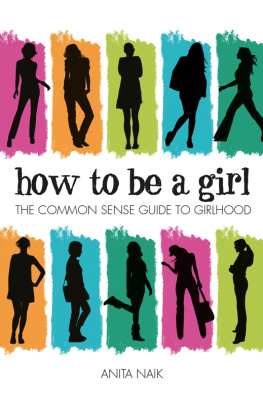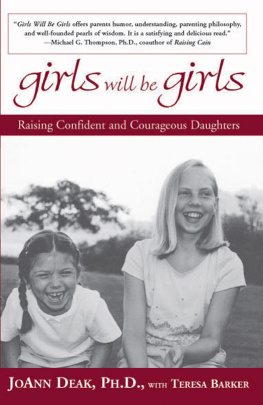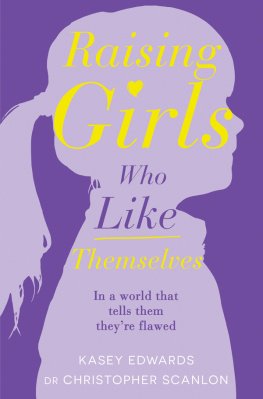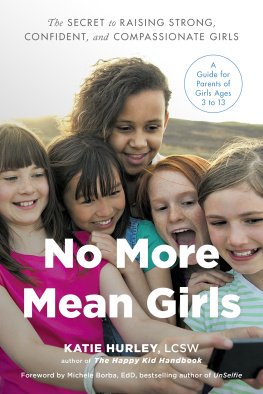... it remains only for women to continue their ascent, and the successes they are obtaining are an encouragement for them to do so. It seems almost certain that sooner or later they will arrive at complete economic and social equality, which will bring about an inner metamorphosis.
Simone de Beauvoir, The Second Sex, 1949
Women of my generation survived the conflict and became stronger from it. We did not want our daughters to experience either the repression or the mandatory rebellion... They dont have to live by our narrow strict rules, the rules of rebellion and resistance. Their lives are rich with porous boundaries, combinations of possibilities that we could not imagine. They can be wildly sexy, soft and smiling, and still be welders and journalists and CEOs.
Judy Upjohn, 50-year-old feminist mother
My generation takes it for a fact that girls are equal to boys.
Dora, 16-year-old alpha girl

About the Author
DAN KINDLON is a clinical and research psychologist specializing in behavioural problems of children and adoblescents. He teaches child psychology at Harvard University, where he has been a faculty members since 1985. He is the author of numerous scientific journal articles and three books including the 1999 New York Times best-selling Raising Cain: Protecting the Emotional Life of Boy (coauthored with Thompson). Currently, Kindlon lectures widely to group of parents, educators, and mental health professionals. He lives outside of Boston.
Notice
Mention of specific companies, organizations, or authorities in this book does not endorsement by the publisher, nor does mention of specific companies, organizations, imply or authorities imply that they endorse this book.
Internet addresses and telephone numbers given in this book were accurate at the time it went to press.
2006 by Dan Kindlon, PhD
Illustrations 2006 by Rodale Inc.
All rights reserved. No part of this publication may be reproduced or transmitted in any form or by any means, electronic or mechanical, including recording, or any other information storage and retrieval system, photocopying, written permission of the publisher. without the
Illustrations by Sandy Freeman
Book design by Tara Long
Library of Congress Cataloging-in-Publication Data
Kindlon, Daniel J. (Daniel James), date
Alpha girls : understanding the new American girl and how she is changing the world / by Dan Kindlon.
p. cm.
Includes bibliographical references and index.
ISBN-13 978-1-59486-2557 hardcover
ISBN-10 1-59486-255-9 -hardcover
ISBN-13 978-1-59486-732-3 paperback
ISBN-10 1-59486-732-1 paperback
1. GirlsUnited StatesPsychology. 2. Emotions in children. 3. Emotions in adolescenceUnited States. 4. Sex role in childrenUnited States. 5. FemininityUnited States. I. Title.
HQ777.K56 2006
305.230820973dc22
2006018444

We inspire and enable people to improve their lives and the world around them
For more our products visit rodalestore.com or call 800-848-4735
For my daughters, Diana and Julia
CONTENTS
ACKNOWLEDGMENTS
Much like a non-narcissistic movie star when she or he prepares to speak after receiving an Academy Award, I find myself remembering how many people I have to thank for the position I now find myself in. With apologies in advance for those I omit, let me begin with Suzanne Gluck, my super-agent, who believed in the project, provided the momentum that got it off the ground, and has been an inspiration throughout. Leigh Haber, my editor at Rodale, helped give the book its structure at the beginning, fine-tuned it at the end and was a delightful collaborator in between.
Special thanks go to my in-the-trenches compatriots: Kenneth Wapner and Amy Sapp. Ken is my longtime personal editor and was involved in every dotted I and crossed T. I cant conceive of writing a book without him. Amy, a brilliant Harvard graduate student, played a major role in every data point, chart, and statistical analysis. The background research she did was stellar and her perspective as the only woman on Team Alpha Girl was invaluable.
I owe a huge debt of gratitude to the administrators, teachers, and parents who not only graciously gave us access to their schools and homes but patiently answered our questions about the girls for whom they cared so deeply.
I also owe immeasurable thanks to Dr. Catalina Arboleda. Several years ago, at her suggestion, we began writing a proposal for a book on the importance of the father-daughter relationship. Although the proposal was never completed, her ideas were part of the germinal matrix from which this book grew. Moreover, she was an extremely understanding partner and co-parent throughout a very difficult period in our lives.
Finally, I deeply thank all the girls and women, alpha or otherwise, who told us the stories that form the backbone of this book. I hope I have faithfully represented you.
INTRODUCTION
Not long ago, I was talking with a group of girls at Greenfield High, a suburban high school in northern New Jersey, about Mary Piphers bestselling book, Reviving Ophelia, which was assigned reading in their English class. The girls reaction to Ophelia was one of confusion. They disagreed with the books premisethat girls are robbed of vitality and self-esteem as they enter adolescence. According to Pipher, our sexist society causes girls to stifle their creative spirit and natural impulses, which ultimately destroys their self esteem.
Who are the girls in this book? asked Sarah, a Greenfield sophomore. I mean, I feel sorry for them, but theyre pretty much losers. Were not at all like them.
From what I could see, she was right. The girls I met were vital. They appeared more confident than many of the boys. They had not lost their voice, something that psychologists typically say happens to girls as they enter adolescence. They feared neither competition from boys nor the consequences of outperforming them.
supposed to be a psychological mess? Recent books on teenage girls have painted a grim picture. Peggy Orenstein, the author of Schoolgirls, has eloquently expressed the prevailing wisdom. Orenstein says that a girls passage into adolescence is marked by a loss of confidence in herself and her abilities, especially in math and science. It is marked by a scathingly critical attitude towards her body and a blossoming sense of personal inadequacy.
If the prevailing psychological thinking was correct, why were Greenfields girls so mentally healthy? Had I wandered into an exceptional classroom with exceptional students? Or was it time to start thinking about girls in a different way? As the father of twelve-and fifteen-year-old daughters, I had a vital personal as well as professional interest in these questions.
When I lectured at American and Canadian high schools, I began to gauge whether the girls I met were more like the self-hating portraits in popular books on adolescent psychology or the self-confident girls at Greenfield High. I immersed myself in cutting-edge scientific literature about gender and sex differences to see what there was to teach me about the girls of my daughters generation. This twenty-first century scholarshipmost of it written by womenprovided me with the latest data on girls mental health, academic achievements, and attitudes.













